Brussels International Exposition (1935)
The Brussels International Exposition of 1935 (French: Exposition Universelle et Internationale de Bruxelles de 1935, Dutch: Brusselse Wereldtentoonstelling van 1935) was a world's fair held between 27 April and 6 November 1935 on the Heysel/Heizel Plateau in Brussels, Belgium.[1]
| 1935 Brussels | |
|---|---|
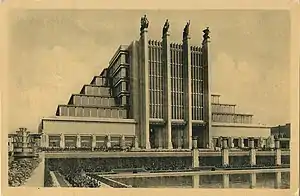 The Palais des Expositions (or Grand Palais) during the 1935 Brussels World's Fair | |
| Overview | |
| BIE-class | Universal exposition |
| Category | First category General Exposition |
| Name | Exposition Universelle et Internationale de Bruxelles |
| Building(s) | Palais des Expositions |
| Area | 150 hectares (370 acres) |
| Visitors | 20,000,000 |
| Organized by | Joseph van Neck |
| Participant(s) | |
| Countries | 24 |
| Location | |
| Country | Belgium |
| City | Brussels |
| Venue | Heysel/Heizel Plateau |
| Coordinates | 50°53′50″N 04°20′21″E |
| Timeline | |
| Opening | 27 April 1935 |
| Closure | 25 November 1935 |
| Universal expositions | |
| Previous | Century of Progress in Chicago |
| Next | Exposition Internationale des Arts et Techniques dans la Vie Moderne in Paris |
| Specialized Expositions | |
| Next | ILIS 1936 in Stockholm |
History
The 1935 World's Fair was the tenth world's fair hosted by Belgium, and the fourth in Brussels, following the fairs in 1888, 1897 and 1910. Officially sanctioned by the Bureau International des Expositions (BIE), twenty-five countries officially participated[2] and a further five were unofficially represented. The theme was colonisation, on the 50th anniversary of the establishment of the Congo Free State.[1]
The exhibition attracted some twenty million visitors.[1][2] The Belgian architect Joseph van Neck was the principal architect of the fair and of the Art Deco Palais des Expositions (also known as the Grand Palais), with its interior concrete parabolic arches, and four heroic bronze statues on piers.
Among many other contributors, Le Corbusier designed part of the French exhibit; the Belgian modernist architect Victor Bourgeois designed the Palais des Expositions (or Grand Palais), the Leopold II restaurant and the Soprocol pavilion. The Belgian art exposition prominently displayed the work of contemporary Belgian artists, including Paul Delvaux, René Magritte and Louis Van Lint, boosting their careers.
The exhibition was photographed in colour by the Dutch photographer Bernard F. Eilers, which was a novelty in 1935.[3]
The Palais des Expositions, and at least three other of the 1935 structures, were re-used for the 1958 Brussels World's Fair (Expo 58), which was held on the same site in 1958.[4]
Gallery
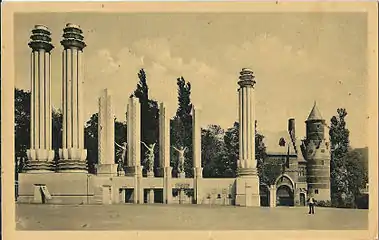 The main entrance
The main entrance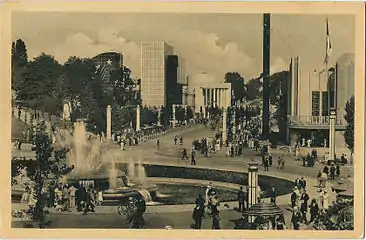 General view
General view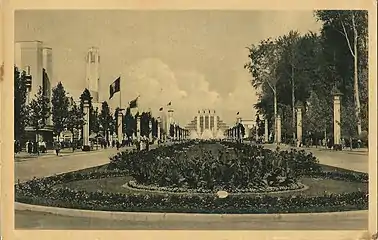 View towards the Palais des Expositions
View towards the Palais des Expositions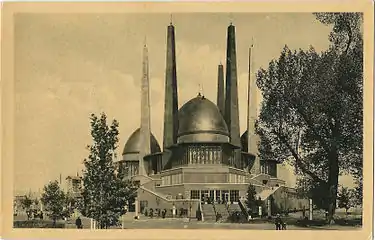 The Catholic life pavilion
The Catholic life pavilion
See also
- The poster for the exhibition was designed by Leo Marfurt
- Brussels Expo
References
Notes
- Lambotte & Pargameni 1935.
- "1935 Brussels". www.bie-paris.org. Retrieved 6 November 2022.
- Bernard F. Eilers photographs The Memory of the Netherlands 2012 https://geheugen.delpher.nl/en
- Schroeder-Gudehus & Rasmussen 1992.
Bibliography
- Coomans, Thomas (1991). "Le Grand Palais du Heysel à Bruxelles (1931-1935), compromis entre monumentalisme et technicité". Maisons d'hier et d'aujourd'hui (in French). 91: 2–17.
- Dumont, Georges-Henri (1979). 150 ans d'expansion et de colonisation (in French). Brussels: Édition Paul Legrain.
- Lambotte, Paul; Pargameni, Charles (1935). Exposition universelle et internationale Bruxelles 1935 : avril-novembre (in French). Brussels: C. Van Cortenbergh.
- Mary, Michel (2004). "Adrien van der Burch, Commissaire général près l'Exposition Universelle et Internationale Bruxelles 1935". Annales du Cercle royal d'histoire et d'archéologie du Canton de Soignies (in French). XXXVII.
- Pacchiani, Serena (2022). "La section italienne à l'Exposition Universelle et Internationale de Bruxelles en 1935: vitrine du régime fasciste ou miroir des industries?". Revue Belge d'Histoire Contemporaine (in French). Brussels. 52 (3): 66–84.
- Schroeder-Gudehus, Brigitte; Rasmussen, Anne (1992). Les fastes du progrès : le guide des expositions universelles 1851-1992 (in French). Paris: Flammarion.
External links
- Official website of the BIE
- BIE description (PDF) (in French)